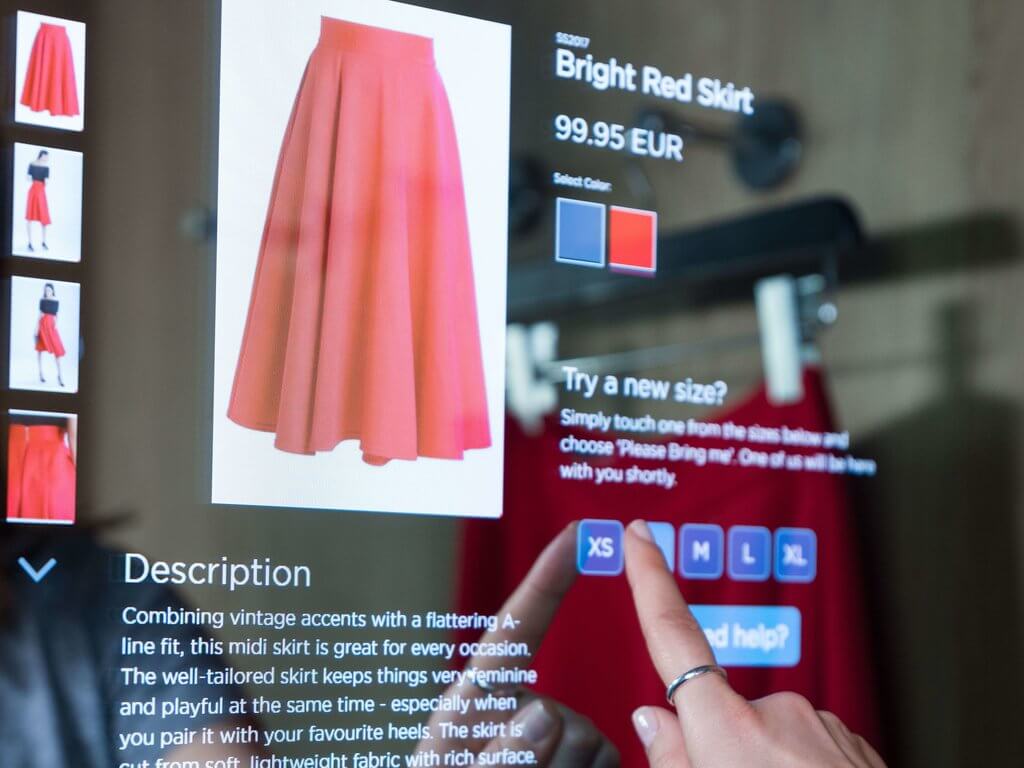Planograms are a key part of running a retail store. In simple terms, they dictate the what, where and, the how many of products on the shop floor.
This article explores planograms, the challenges they present and how retails ongoing digital revolution along with artificial intelligence is changing planograms as we know them.
What is a planogram?
A planogram defines the location and quantity of products to be placed on display. They essentially function as blueprints for all merchandise within a store.
Alongside the visual merchandising element, planograms aim to optimise article availability and thus specifically stimulate sales.
So, a store planogram has two aspects:
1 – The Merchandising: which articles are presented on the sales floor and how (visual merchandising)
2 – The detailed quantities for individual colour and sizes (availability optimisation)
For example, a planogram might state where a formal shirt is displayed on the shop floor. The planogram will also state what quantities should be displayed, specific to different sizes and colours. So the planogram may state 3 mediums, 2 smalls, 2 larges and 1 extra-large are available on the shop floor, and so on.
Ideally, merchandising and planograms go hand in hand: customers are inspired by the presentation and then, their desired product is available in the matching size. The reality, however, often paints a different picture.
Planogram – Merchandising
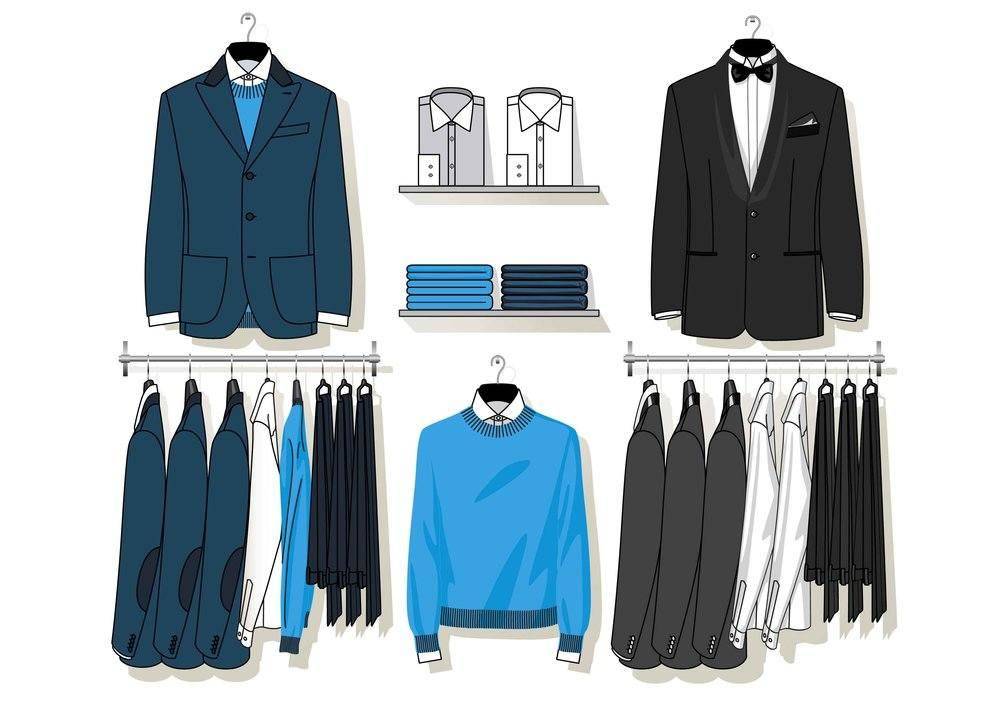
Planogram – Quantities and Priorities

Visually appealing and available in relevant sizes
What are the challenges of setting and maintaining a retail planogram?
Breaking this down, there are two questions that retailers face:
1) How do you define a planogram for my stores with a suitable size distribution?
The first question can be a challenge for retail depending on your definition of suitable. The reality is simply that manually creating and defining different size distributions for every single product is incredibly time-consuming and rarely worth the effort. This means generally stores will have a single set size distribution or ratio for every product in the store. This certainly could be worse, but it could (and can) be better….
2) How do you maintain the planogram on the shop floor? I.e. how to ensure that the products on the planogram are always on the shop floor
This, on the other hand, is a major challenge for retailers. What good is a planogram if it’s not adhered to? For example, if a planogram states that a size XL should be on the shop floor at all times but it is missing due to inaccurate or slow replenishment/refill, and a customer who needs that size can’t find it, more often than not that sale is lost.
There are two ways steps that go a long way to fixing this:
- Use a more specific and data-driven planogram in the first place (What we’re going to explore now)
- Having a better replenishment process in the store. (Like this one)
How does AI change the planogram?
Manual maintenance and adjustment of specific planograms is rarely a realistic option for retailers, especially when it comes to specific size distribution for individual products and stores.
By utilising artificial intelligence and machine learning procedures, it is possible to automate this process to define a precisely optimised size distribution for all articles across the store.
Not only does this save an enormous amount of planning time, but it also addresses the ongoing dynamics in individual stores. The self-learning system adapts to possibly changing conditions and continuously optimises the plan.
- Produces automated planograms based on sales data
- Produces optimised planograms for individual products
- Produces optimised planograms specific to the individual store
- Constantly adapts and optimised the planogram based on new data
AI planograms in action with the Detego platform
If this all sounds theoretical, its not.
During the operational process in the store, Detego InStore also supports the store personnel at several occasions: The software offers two parameters that provide information about article availability at any time and therefore represent important KPIs:
- On-floor availability: The percentage of all available articles that are currently displayed on the sales floor
- Planogram compliance: Provides information on how well the planogram with its individual size distribution is implemented on the sales floor
If one of the two parameters fall below certain threshold values, store staff needs to action: In addition to classic ERP systems, Detego InStore offers a finer level of granularity in the stores, by telling store staff that certain articles are available in the backroom but not on the salesfloor and therefore need to be refilled to comply with the predefined planogram.
Retailers benefit from a complete process for the planning and implementation. Another advantage: Refill advices in the app are sorted such that the search in the back room is made as efficient as possible by minimising walking routes.
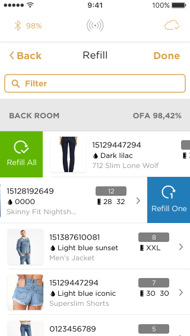
With AI planograms, shelf space is used for top sellers and is not wasted on sizes that are rarely or never bought. With its self-learning components, the Detego platform for the store makes a suitable proposal for all sizes and facilitates implementation in daily processes – including relevant KPIs for measuring performance. And if a certain size is not available in one store, the platform offers an exact inventory view of surrounding stores – ready for click & collect.
Benefits for retailers:
- Individually optimised AI planogram per store
- Efficient use of shelf space according to bestsellers per store
- Guided processes: from planning to refilling
- KPIs to provide insights on operational excellence per store – in real-time
Benefits for consumers:
- High on-floor availability for the locally popular sizes
- Positive customer journey
- Overall increased article availability through exact inventory data on the entire store network – including reservation options
Did we spark your interest?
There’s a lot of talk about artificial intelligence at the moment, but not that many practical use cases, especially in bricks-and-mortar retailing. We should know. We were one of the early adopters of machine learning in the development of our retail software and have launched a popular chatbot tool to help consumers get quick answers to simple stock enquiries without having to seek out a sales assistant or call customer service.
Aside from a general foreboding that there’s more talk about AI than action, and that machines might eventually outperform humans, we get the distinct impression that most retailers are still trying to understand the basics about what machine learning can actually do for their business and how AI will help with consumer engagement. So, here’s our attempt to unravel the mysteries behind the topic of artificial intelligence in retail and see whether it’s a passing fad, or something retailers should be paying more attention to.
Knowing your product
There is one field where artificial intelligence has already made a significant difference, and that’s getting to grips with vast amounts of data and making much more informed product recommendations. It’s a technique that was spearheaded online by the likes of Amazon – making suggestions about what other products you might like – but still has a long way to go on the high street. There just isn’t a very joined-up approach between the worlds of online and bricks-and-mortar retailing. And the availability of products is often neglected; not many retailers take into consideration what products would be best (or most profitable) to shift.
That’s where AI comes in.
Artificial intelligence, by amalgamating lots of data and making decisions based on a variety of factors – product availability, purchase history, current trends, profitability, and so on – gets better and better at making reasoned choices. All this might sound obvious, but it’s something very few retailers actually do in their stores. Most retailers still have rather disjointed processes across various channels and different departments suffer from a lack of data input on a consistent level. Some processes are semi-automated, but many – such as merchandise planning and product assortments – remain largely manual. For example, buyers still base most of their decisions on out-of-date sales figures and gut instinct, rather than using much more efficient machine learning tools.
Artificial intelligence is ideally suited to forecasting and stock allocation. These processes historically tend to be quite manual and cumbersome and generally are not managed that efficiently – largely because it’s just too much work to find the ideal mix. It’s something that’s typically done by relatively small departments, even though product selection and stock availability are clearly so fundamental to a retailer’s bottom line. Yet self-learning mechanisms can be put in place to maximise availability and promote what’s most likely to sell.
In most stores today, store staff are prone to stack shelves based on whatever available sizes there are and what will fit, rather than having technology that knows what will be best for that particular store’s profit. By using AI, we’ve found that different stores, even in the same town, might require completely different sizes of garments to maximise their sales.
Coupled with RFID tags on every item to help monitor stock with near hundred percent accuracy, artificial intelligence can be used to improve on delivery performance and the distribution of inventory between stores, the warehouse and even to the consumer. For example, we found one retailer flummoxed by hundreds of cartons of products having been shipped but never received and various departments spending a long time trying to resolve – something a machine could unravel in seconds. It’s not uncommon for retailers to not know exactly where stock is at any particular time, but the joy of artificial intelligence is ensuring that human mistakes are minimised and promises – such as a marketing campaign offering the latest product release at a special price in chosen stores – are always fulfilled.
Human machines
While there’s still a lot of hype about chatbots at the moment – robots to help with customer service – and undue pressure to adopt some of the latest (and arguably more advanced) techniques inherited from the online retail world, this is just the start of what can be done regarding artificial intelligence in retail.
Chatbots, available on people’s smartphones for asking advice when they enter a store, can give an instant link to customer services and access to a much wider catalogue of products and services. The appeal of chatbots has not only come about because young people, in particular, are now used to dealing with them online; but also because a lot of people don’t really want to have to track down a sales assistant in a busy store and then get the ‘don’t know’ or ‘don’t care’ response that can ruin a retailer’s reputation. Simple, product-related tasks and stock checks are ideally suited to machines. We’ve even found sales conversion rates to be up to five percent higher in stores where we’ve introduced chatbots with AI-powered product recommendation tools.
Clearly, chatbots won’t ever replace humans working in stores. But they can certainly complement them: often proving more reliable; never prone to sickness or breaks; not trying to drag you into a conversation and oversell, and always available 24/7.
Increased stock transparency and profitability, as well as better customer engagement, are what will help keep retailers flourishing – allowing them to compete with the increasing threat of online retail goliaths who are setting the trends for the future of shopping. Artificial intelligence isn’t just another fad. It might seem like fiction, but it’s clearly here to stay, outperforming expectations all the time.
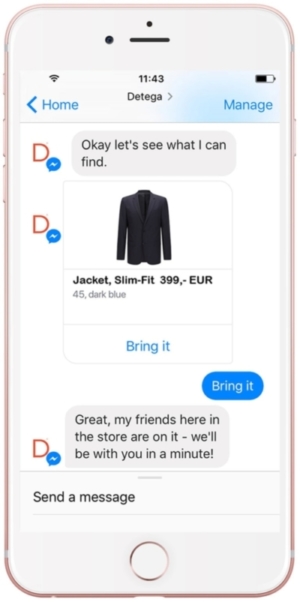
Retail software specialist, Detego, will showcase three of its software solutions at EuroCIS, taking place from 19 – 21st of February 2019 in Düsseldorf, Germany. Visitors to Europe’s leading trade fair for retail technology can experience Detego’s market-leading solutions for the fashion retail industry, including real-time inventory intelligence and pioneering IoT and artificial intelligence (AI) projects. The live demos being showcased will be part of an impressive booth setup (Hall 9, booth #C04) which showcases the future of physical retail stores.
For inventory management of the store, Detego offers the InStore Lean Edition which meets the demands of the fashion retail industry for a quick-start solution into the digital store. Offered as a SaaS (Software-as-a-Service) solution with cloud hosting, retailers benefit from high inventory accuracy and consistent article availability at low cost. This is possible through fast and accurate stocktakes and automated replenishment processes, bringing long-term benefits to fashion retailers and most importantly, delivering quick results. The app-based solution can be active within hours and has a clear path of scaling to ensure rapid deployment and an easy functional extension to the Detego InStore Full Edition. “More and more fashion retailers are living by the mantra of ‘keep it simple’ for their RFID implementation which is exactly why we successfully implemented across the world the Detego InStore Lean as an ‘out-of-the-box’ SaaS-based RFID solution.” Says Kim Berknov, Executive Chairman of Detego.
The fitting room is the most important place in the entire store when it comes to purchasing decisions being made. This means that it’s crucial to provide support and additional services for customers. Detego’s Smart Fitting Room provides product recommendations, such as matching items available on the sales floor that can be brought directly to the fitting room by sales staff via a “call-to-assist” button. The customer can gain access to the benefits of e-commerce by looking up other products, checking for availability, reserving articles or having them delivered directly from the store to their home. Links to videos or social media feeds can also help. These value-adding services are what continue to drive consumers to shop in-store.
Answering as many questions as possible for shoppers through AI, Detego’s chatbot supports the sales personnel and bridges waiting times for customers until there’s a salesperson available for individual service. The virtual store assistant accompanies customers throughout their entire shopping experience and provides additional support in the vital decision-making process, such as making product recommendations and earmarking other popular items, bestsellers, discounted articles or product variants. The AI capabilities are not just limited to the chatbot itself, but also work continually in the background by communicating with other systems in the store. The chatbot checks the actual availability of articles and compiles data about customer types and their preferred article combinations and choices. As a result, recommendations become more meaningful and personal and only articles immediately available in the store are recommended.
“We want to introduce fashion retailers to solutions that support them in their daily challenges,” says Dr. Michael Goller, CTO at Detego. “We can show how fashion retailers can positively influence buying decisions and how a digital fitting room or a chatbot help in the sales process, as well as witness how several global fashion brands have successfully adopted the Detego InStore Lean Edition.”
Detego, a provider of innovative software solutions for the retail industry, will be showcasing the latest digital in-store solutions on January 13-15 at NRF 2019. Returning as a co-exhibitor on the SAP booth (#3426), Detego will display their RFID-based inventory management software and latest AI applications for retailers.
Detego has been complementing the SAP offering in fashion retail by utilizing IoT technology and providing SAP systems with real time data on item level. Exhibiting at NRF will be the Detego InStore Lean Edition, a new mobile solution for retailers, offering faster and cheaper access to the benefits of digital connectivity via an RFID based system. This solution allows fashion retailers to quickly adopt a “smart” replenishment process and carry out “intelligent” stocktakes, by starting small and scaling across the entire store network. Offered as a SaaS (Software-as-a-Service) model with cloud hosting, retailers benefit from high inventory accuracy and consistent article availability at low cost. Detego’s software has already proven to be the most cost-effective and fastest to implement on the market with over 1500 stores running on Detego around the globe.
To complement their core product offering, Detego have also developed AI applications which benefit both retailers and consumers alike. Detego’s new digital assistant/chatbot can be used at any time on a customer’s smartphone to help provide more pertinent product information or recommendations, based on real-time data on actual availability and customer preferences. The built-in machine-learning and artificial intelligence (AI) capabilities adapt to the ever-changing dynamics of retail, which means that results get better and better over time.
Detego has also found opportunity within AI to help revolutionize the planogram. Since the manual maintenance of the planogram per store can be enormously time-consuming, Detego’s self-learning system adapts to possibly changing conditions and continuously optimises the individual planogram per store. “By optimising the sizing profile of individual items for each store and greatly simplifying the in-store refilling process, we provide retailers with tools that make it easier for them to plan and implement optimum product presentation and thereby help them to boost their sales.” Says Michael Goller, Detego CTO.
This webinar discusses intelligent planograms and how they enable an individual size distribution for fashion retail stores and make sure that products are available on the sales floor in the appropriate sizes.
It provide insights into how the self-learning system adapts to possibly changing conditions and continuously optimises the plan – with a direct impact on the store revenue.
Retail software vendor, Detego, will be showcasing its latest digital in-store solutions for retailers at NRF, the world’s largest retail industry show on January 14-16 in New York, as a co-exhibitor on SAP´s booth # 2733. These include a new mobile solution for retailers, offering faster and cheaper access to the benefits of digital connectivity, as well as Detega, a new chatbot that supports customers throughout their entire shopping experience.
Detego’s software, in combination with tiny radio-frequency identity (RFID) tags on every item, makes it easier for retailers to boost inventory accuracy and on-shelf availability to levels consistently above 98 percent – a huge increment compared to the industry average of 75 percent. While Detego’s chatbot opens up the entire store chain and digital catalogue to consumers.
Detego says that it has decided to release a leaner version of its full product suite so that retailers can quickly experience the advantages of RFID-enabled merchandise management, which include reducing the number of markdowns and fewer gaps on shelves.
“The launch of Detego’s InStore Lean Edition provides a quick-start solution that’s productive within hours, not weeks or months, without the complexities typical of most IT implementations,” says Detego’s CTO, Michael Goller. “Fully hosted and managed in the cloud, it is being targeted at retail chains, pop-up stores, franchisees and brand store owners who want to benefit from modern in-store technologies without the need to invest in fully fledged, large-scale IT projects.”
The new software is highly modular and scalable, meaning that retailers can start with just a few stores and scale to hundreds or even thousands within a short period of time. Additional features can be added at later time, including retail analytics, omni-channel services such as “click&collect”, and other consumer engagement and supply chain applications.
The fully hosted and managed SaaS (software-as-a-service) offering that runs on SAP’s Cloud Platform enables retailers to seamlessly integrate systems across various applications. The combination of the SAP Cloud Platform and the analytics and merchandise software from Detego provides the basis for customer-centric processes and services, as well as real-time applications in omni-channel retailing. In the light of ongoing consolidations within retail chains, this gives fashion retailers a competitive advantage and differentiating element for their brick & mortar stores.
Detego’s new chatbot can be used at any time on a customer’s smartphone to help provide more pertinent product information or recommendations, based on real-time data on actual availability and customer preferences. The built-in machine-learning and artificial intelligence (AI) capabilities adapt to the ever changing dynamics of fashion retail, which means that results get better and better over time.
Specialist retail software provider, Detego, has successfully eliminated over three million stock shortages during various pilots and ongoing retailer projects after using merchandise management software powered by artificial intelligence to help combat perilous out-of-stock situations.
Thanks to tiny radio-frequency identity (RFID) tags attached to every item and the real-time monitoring of articles from warehouse to store using connected devices, Detego is trying to make sure that missing sizes and gaps on the shelves are no longer such an issue and headache for retailers. Projects have shown high article availability and near hundred percent inventory accuracy when using IoT technology and the AI powered Detego suite, compared to an industry average of around seventy percent in most fashion retailers’ businesses.
The AI software is also being used to analyse vast amounts of data and uses machine-learning to better understand the behaviour of several million consumers, deriving insights and actionable recommendations for retailers, it said.
Analysis shows that the vast majority of shoppers today still favour visiting a store. This trend is particularly strong in fashion, although a growing proportion are switching to other omni-channel options, including shopping online, via smartphones, or click-and-collect from nearby stores.
“Even with all the advances of the digital age, more than 80 percent of retail sales happen in bricks-and-mortar stores. In the fashion industry, customers still want to walk into shops to see, touch, and try on different outfits. While customer motivations for entering stores are largely the same as they were twenty years ago, their expectations are much higher. Customers who can find anything they want on their smartphones in seconds expect similar instant gratification in stores. They want the items they see online to be available in the store and in their preferred size, style and colour,” said Uwe Hennig, CEO at Detego.
Detego has seen significant growth in omni-channel services this last year, recording over 1.5 million omni-channel transactions through its software suite.
“Omni-channel services like click-and-collect are another important cornerstone for connecting the best of the online world with the benefits of bricks-and-mortar,” said Hennig. “Customers now expect a seamless, unified retail experience across multiple channels: for instance, being able to click on and reserve any items discovered online for trying on in a store the next day.”
Detego, a market leader in business intelligence and real-time analytics for the fashion retail industry, is launching new software to actively support retailers in their consumer engagement strategies. As part of its omni-channel retailing software suite, Detego InChannels bridges the gap between online and bricks-and-mortar retailing by using more digital touchpoints in stores. These include digitally connected “smart fitting rooms” and interactive screens on the sales floor, as well as the introduction of a new Detego chatbot that accompanies customers throughout the entire buying process at any time on a customer’s smartphone.
Detego’s pioneering Smart Fitting Rooms technology allow customers to directly communicate with store personnel via interactive screens in the fitting room and request other products or sizes be brought to them (or even be delivered to other locations). A global sportswear retailer is currently rolling out the concept across its store estate, including arming its staff with iWatches to help guide them with more informative, real-time information.
The software provides reliable data on the number of articles that have been tried-on and sold or not (with fitting room conversion rates unique to the system). Social media feeds built into Detego InChannels also give customers the ability to post recommendations or put together outfits that can be shared within their community. This helps boost levels of engagement with customers, particularly in stores, increasing interaction across a broader range of products.
By using Detego InChannels, retailers are able to get a much deeper understanding of consumer behaviour across various different channels. Detego claims that its software’s more precise and intelligent product recommendations – based on using real-time data on product availability – can increase sales and reduce the number of unnecessary markdowns. For instance, only articles that are currently in-stock are flagged up and the intelligent system can even be used to encourage more sales of otherwise slower-selling or higher margin items. The AI capabilities of Detego’s software also mean that the recommendations get better and better as the logic behind the self-learning system continually improves and increases its functionality.
“Retailers have to adapt their store processes to the expectations of a new, digital customer using more modern-day technologies that bring the customer, store and online worlds together for good,” says Uwe Hennig, CEO at Detego.
Usually, the fitting room is the place where purchasing decisions are made by customers. That is enough reason for fashion retailers to leave nothing to chance. The “Smart Fitting Room” offers possibilities of real customer interaction and to gain additional competitive advantage by meeting the exact wants and needs of today’s shoppers.
However, the “Smart Fitting Room” not only changes the shopping experience for customers, it also provides retailers with important insights on customer preferences.
It’s a highlight in the store for both the customer and the retailer.
Benefits for customers
Via integrated sensors, the Smart Fitting Room identifies the exact articles a customer brings into the fitting room. On screens or mirrors, it then indicates which colours, models and sizes are available directly in the store, in the web shop, or in other stores. Similar to ecommerce, customers receive recommendations for suitable articles based on their preferences, and can browse through the full range of articles, check article availability in real-time and request that sales personnel bring specific articles directly into the fitting room via a call-for-assistance function. The customer perceives this digital shopping experience as the merging of different sales channels. The store, with all its multisensory impressions, presents itself as also being “online” and therefore ensures a completely positive customer journey in the long run.
“Smart” for the customer
- Shows different product combinations
- Makes product recommendations
- Article availability check
- Shows full range of articles to browse through
- Additional information, videos, social media integration
- Customer-friendly fitting (Article-Bring-Service)
- Enables digitally supported purchase decisions
- Direct reservation or ordering of articles
- Different delivery options (delivery to home address, from another store, etc.)
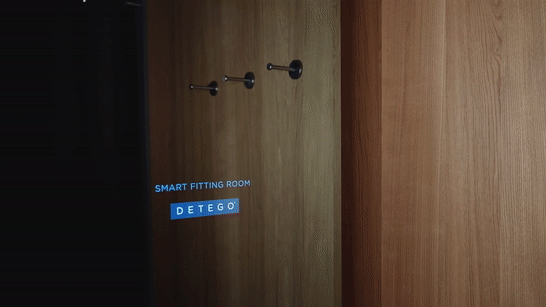
Benefits for retailers
With the Smart Fitting Room, retailers recognise the potential for up- and cross-selling and use this opportunity to drive the digital transformation in the store through modern forms of communication between customers and the sales personnel. In particular, young fashion brands of the smartphone generation can use the Smart Fitting Room as a powerful tool for the enhancement of customer loyalty. Customer requirements like “ship-from-store” or recommendations in real-time on social media platforms can help retailers stand out from the competition. Small stores situated in expensive A-locations are able to present their full range to customers – an opportunity for additional sales.
What’s more, the Smart Fitting Room provides valuable data: e.g. which articles are often tried-on but rarely bought. The consideration of customer preferences increases the retailer’s “operational excellence” making it possible to offer customers what they really want. In addition, analysis also supports merchandise optimisation.
The concept of the Smart Fitting Room can also be expanded for future personalisation. When logged into their account, customers can receive offers based on their individual fashion preferences.
“Smart“ for the retailer
- Promotes up- and cross-selling potential
- Interactive dialogue between customers and store personnel
- Shows full range of products (Virtual-Endless-Shelf)
- Retail analytics: insights on customer preferences
- Increased operational excellence, optimisation of merchandise plan
- Omni-channel: Integration of online and brick-and-mortar retail
- Engagement with store and brand
- Personalised customer offers
The challenge of today’s modern retail is to get customers in the store. This enhances a retailer’s chance for “conversion”. The Smart Fitting Room, with its integrated services, is the perfect tool for that.
Want to find out more about Detego’s Smart Fitting Room solution?
More from the blog
Just smoke and mirrors? Breaking down the business case of Smart Fitting Rooms
Smart Fitting Rooms are finally live in the retail market. So what exactly are they, what do they do, and what kind of value do they add to retail business?




